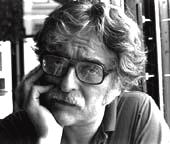Random thought number one:
Relatively recently, Walter Isaacson, the new chairman of CNN, made
a number of public statements about the need to broaden CNN's news
coverage with more emphasis on entertainment, personal health, technology
and computer coverage - and to reduce foreign and government coverage.
He also spoke about changes in the CNN presentation - more personalities
in the on-camera personel and more "info windows" on the
screen. Among other things, he said that he wanted the news to be
more "fun." In many respects, these were the television
equivalents of the changes he had overseen at Time Magazine.
After the World Trade Center and Pentagon tragedies, Mr. Isaacson
recanted, talking about the need of doing the terrorism story "seriously
and reliably."
If anything, CNN was late in deciding to downsize serious news. Many
of us who reported foreign news remember with great sadness the downsizing
of the excellent CBS foreign coverage, downsized under the leadership
of Lawrence Tisch. This was followed by the appearance of a number
of soft news programs on all networks that let the networks get their
money's worth out of their newly downsized news departments and their
staffs.
One of the few pleasures one could take in the days following September
11 was the exceptional job done by the networks based in New York,
by their Washington bureaus, by MSNBC and CNN on cable and by the
New York Times.
But it will be interesting to see if the networks are willing to spend
the money to rebuild the news departments, especially abroad, if viewer
interest diminishes. And it will be equally interesting to see if
the audience for
serious news reverts to wanting coverage of large breasts, celebrity
antics and the indescretions of government officials. After all, it
was this interest that finally forced CNN, the big holdout, to do
"fun" news.
Random thought number two:
After the first blast at the World Trade Center, my son went to the
roof of his apartment building in Brooklyn to photograph. He lives
in Park Slope, not Brooklyn Heights which is closer to Manhattan.
As far away as he was, papers from offices in the World Trade Center
were floating down on him.
After he made the photographs, he went to the local firehouse. At
the firehouse they said they needed dog food and athletic socks -
dogfood for the sniffer dogs, dry socks for the fireman who were working
long shifts with minimal breaks. He brought socks and dogfood to the
firehouse until the relief work became more organized. Since then
he has been accredited and photographed at the site. Twelve of the
27 men who were part of Squad Company One in Park Slope are missing
or dead. In addition to the many firemen and policeman who rushed
to the scene and are presumed dead, photographer Bill Biggart and
tv cameraman Glen Petit are also presumed dead.
Random thought number three:
Twice I have photographed surgeons who at the end of operations went
somewhere quiet and cried. One had operated on a family member; the
other had just removed a donor organ needed to save a life and realized
it was damaged and there would be no transplant. They were ice during
a medical procedure in which they had to take a scalpel and cut into
human flesh. And they were devestated by what they had seen. It taught
me a lot about photography.
In a recent piece in the New York Times, Sarah Boxer talked about
the ability of the photographer to remain objective and use his or
her skill while photographing something that is horrible. She is very
flattering. But, the skill is drilled into you by experience and practice.
Most of your decisions aren't conscious. Photography of the trivial
recquires much more conscious thought. And she left out the sadness
after it is all over.
There is skill. But, if there is no sadness, then you are not far
from the point where you pictures are empty excercises that touch
no one.
Random thought number 4:
A good while back, someone from Kodak told me photography was the
number one "secondary" hobby. There are many more people
who collect stamps and take pictures or do woodworking and take pictures
than stamp collectors who do woodworking. (That must be even more
true now that people have digital cameras and can email pictures of
the kids to the relatives.) God bless the amateurs that were in New
York on September 11, tourists and amateur photographers in the area;
fireman, rescue workers and doctors who arrived on the scene with
a camera.
The professional photographer was on the scene just as quickly. Witness
the New York Times' Chang Lee photographing the World Trade Tower
exploding or an uncredited Associated Press photographer picturing
fireman rushing up the stairs of the World Trade Center.
Being away from New York on that day was painful - not because I wasn't
photographing, but because I wasn't there when my City was hurt. Seeing
the credit lines and photographs of so many old friends and associates
made me happy and sad. Seeing the exceptional pictures by New Yorkers
who were not professional photographers made me proud and sad.
Random thought number five:
The ID photographs of 347 fireman and the countless family pictures
posted by people looking for missing relatives.
Bill Pierce
Contributing Writer
bicpi@earthlink.net

